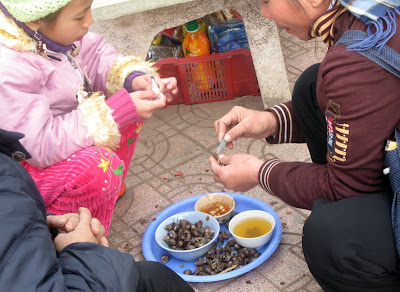
We've been cold ever since we arrived here in Hanoi, although it's not really that cold.
After three months in Thailand, the last five weeks on the beach on Phuket, we arrived in the northern capital city to more weather shock than anything else.
It's been overcast since we arrived four days ago but the day time highs are beginning to reach into the mid-seventies. There's even a forecast for some mid-eighties by the middle of next week.

Hanoi has a vastly different feel than Saigon (Ho Chi Minh City) in the south. At times it feels like a completely separate country.
One thing it does have in common with Saigon is the street noise. Motorbikes are the most noticable things on the streets here. Maybe not as much as in Saigon but still an overwelming presence. Cars and trucks are becoming increasingly afforadable so their numbers are adding to the traffic on the often narrow roads.
Horns from cars, trucks, and buses are used to alert motorbikes of their presence.

Street life is always interesting - mostly because it's so different from what we experience back home.
Above are people snacking on snails on the street.
.JPG)
The street markets are pretty much as they are throughout Southeast Asia.
Plenty of fresh vegetables, fish, and meat.


Fresh baked baguettes, along with delicious coffee, are two things the Vietnamese have mastered from their French colonial days.

Wine in jugs on display outside a local wine bar. Yes, those are starfish.


The historic Old Quarter is one of the top destinations in Hanoi.
The streets are lined with shops and historic old buildings. You can shop, stroll, or just relax on the street cafes enjoying a cup of coffee or tea.

A woman carrying around a portable Pho stand.

Motorbikes congesting the sidewalks. There are often parking attendants hired by the local merchants tending to the parking. Sidewalks are not really for walking here in Vietnam.
In the cities they're often used for parking motorbikes or for merchants setting up their tea or food stands.


We're staying in an apartment on the top floor of this building housing a trendy bar/restaurant called
Daluva serving everyting from tapas to pho, and all kinds of interesting cocktails.
Daluva is located in the trendy, up and coming Tay Ho District on the West Lake. It's away from the hustle and bustle of the Hoan Kiem District and the Old Quarter but just a ten minute taxi ride away (about $3.00).


And here's the best thing about
Daluva, aside from the wonderful staff and friendly guests. Breakfast of French Crepes with bananas and Passion Fruit sauce. Yummy!
Hanoi is celebrating it's
1000th year anniversary in 2010 and they expect up to two million foreign visitors and eight million domestic visitors this year. The city, with it's limited capacity, will be pushed to its limits. The official anniversary date is 10 October 2010.
Sounds on the street.
Crossing the street can be a bit tricky to a novice streetwalker here.
You could spend hours waiting for the traffic to stop, but it won't until late at night.
Do as the Vietnamese do and start inching your way across a busy road. You'll be surprised as the traffic parts, like the Red Sea, flowing smoothly in front or behind you. Whatever you do, don't make any unpredictable movements. Freeze if you have to but never lunge forward.
You pat my back...
* When you go:
-Dollars are welcome in most higher end establishments but the Vietnamese Dong cannot be refused by law. Exhange rates are currently in the 18,800 to one USD range. Change $100 USD and you'll be carrying around almost two million Dong. A cup of coffee will run you about 18,000 Dong on the street.
-ATM machines are available throughout the city.
-Exchange dollars at hotels or banks. Traveler's checques at banks only.
-Bring smaller US notes for small purchases.
-A taxi from the airport into town will cost around $16 USD including the tolls.
-Tipping is not required but becoming more common in the large cities of Hanoi and HCMC, and almost expected at high end restaurants.
Hanoi time:


 When we first visited Hanoi in 1998, we didn't make the trip to Halong Bay. When we returned home, we heard plenty of "you didn't go to Halong Bay?". Not sure if it's the same as "you went to Paris and didn't go to the Eiffel Tower?" but we didn't actually decide on Halong until we were persuaded by our hosts here in Hanoi.
When we first visited Hanoi in 1998, we didn't make the trip to Halong Bay. When we returned home, we heard plenty of "you didn't go to Halong Bay?". Not sure if it's the same as "you went to Paris and didn't go to the Eiffel Tower?" but we didn't actually decide on Halong until we were persuaded by our hosts here in Hanoi.



 We stopped at one of the many fishing villages on the Bay. Fishing, shrimping, oyster farming are still a big part of life for the people here, but I suspect shuttleing tourists around the bay can be just a lucretive.
We stopped at one of the many fishing villages on the Bay. Fishing, shrimping, oyster farming are still a big part of life for the people here, but I suspect shuttleing tourists around the bay can be just a lucretive.
.jpg)


















.JPG)




























